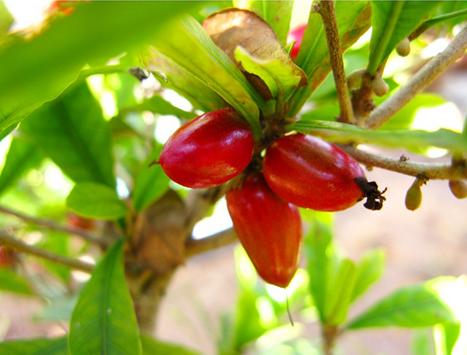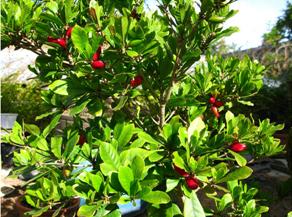

about the miracle berry
home
classification
growth
miraculin
references
about the author
the miracle berry
The miracle berry (aka miracle fruit or sweet berry) is a tiny fruit from the plant Synsepalum dulcificum, literally meaning "sweet joined sepal" (a part of the leaf). The plant grows as a bush up to 20 feet tall in its native habitat (only up to about 6 feet tall anywhere else) with small, white flowers and can sprout up to 300 fruits at once - tiny red berries the size and shape of olives. The fruit contains a seed in the center surrounded by a fleshy, opaque pulp. In the fruit lies the magic of this plant and the source of its common name; one of its chemical constituents, miraculin, alters the taste buds to cause nearly everything eaten within the following hour to taste sweet. While the berry itself has very little taste, its effects are so 'miraculous' that it has become a source of entertainment in cities across America. The berry has a very short shelf-life, and is therefore relatively expensive. To learn about the various miracle berry products and where to buy them, check out the miraculin page.
history
French explorer Reynaud Des Marchais was the first to document the miracle berry in West Africa in the early 1700s after observing the native people eating it. In the mid-1800s, botanist Dr. W.F. Daniell published a paper which popularized the fruit and began an onslaught of research and testing of the berry, especially as a sugar substitute. America was introduced to Synsepalum dulcificum in the early 20th century by David Fairchild, an employee of the US Department of Agriculture, and in 1968, miraculin was succesfully isolated from the berries.
habitat
Synsepalum dulcificum is native to West Africa, but is currently commercially farmed by farmers of rare fruit in Taiwan, Jamaica, Puerto Rico, Guam, and South Florida. It grows best in a humid, warm environment and while resistant to varying water levels, it cannot withstand any sort of freezing. The plant prefers a slightly acidic soil (pH 4.5-5.8) and produces edible fruits about 3 years after planting. The fruit is "in season" May through September, though berries are generated year-round.
MultipleOrganisms.net * University of Wisconsin - La Crosse * Home * About the author
©2012 - All Rights Reserved